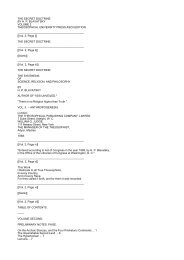You also want an ePaper? Increase the reach of your titles
YUMPU automatically turns print PDFs into web optimized ePapers that Google loves.
Plate I.<br />
Sacred Texts Egypt Index Previous Next<br />
THE BOOK OF THE DEAD.<br />
Translation<br />
PLATE I.<br />
Vignette: The scribe Ani, standing with hands raised in adoration before a table <strong>of</strong> <strong>of</strong>ferings consisting<br />
<strong>of</strong> haunches <strong>of</strong> beef, loaves <strong>of</strong> bread and cake, vases <strong>of</strong> wine and oil, fruits, lotus, and o<strong>the</strong>r flowers. He<br />
wears a fringed white and saffron-coloured linen garment; and has a wig, necklace, and bracelets. Behind<br />
him stands his wife "Osiris, <strong>the</strong> lady <strong>of</strong> <strong>the</strong> house, <strong>the</strong> lady <strong>of</strong> <strong>the</strong> choir <strong>of</strong> Amen, Thuthu,"[1] similarly<br />
robed and holding a sistrum and a vine (?)-branch in her right hand, and a menat[2] in her left.<br />
[1. See Plate XIX.<br />
2. The menat, which is <strong>of</strong>ten called "<strong>the</strong> counterpoise <strong>of</strong> a collar," consists <strong>of</strong> a disk, with a handle attached, and a cord. It<br />
was an object which was usually <strong>of</strong>fered to <strong>the</strong> gods, with <strong>the</strong> sistrum; it was presented to guests at a feast by <strong>the</strong>ir host;<br />
and it was held by priestesses at religious festivals. It was ei<strong>the</strong>r worn on <strong>the</strong> neck or carried in <strong>the</strong> left hand; and it was an<br />
emblem which brought joy to <strong>the</strong> bearer. Interesting examples <strong>of</strong> <strong>the</strong> pendent menat in <strong>the</strong> British Museum are No. 17,166,<br />
inscribed, "Beautiful god, lord <strong>of</strong> <strong>the</strong> two lands, maker <strong>of</strong> things, King <strong>of</strong> <strong>the</strong> North and South, Khnem-ab-Ra, son <strong>of</strong> <strong>the</strong><br />
Sun, Aahmes (Amasis), beloved <strong>of</strong> Hathor, lady <strong>of</strong> sycamore trees"; and No. 13,950 * in faïence; and Nos. 8172, 8173,<br />
and 20,607 in hard stone. No. 18,108 is <strong>the</strong> disk <strong>of</strong> a menat in faïence, inscribed, Hathor, lady <strong>of</strong> <strong>the</strong> town <strong>of</strong> Anitha." No.<br />
20,760 is a disk and handle in bronze, <strong>the</strong> disk having, in hollow work, <strong>the</strong> figure <strong>of</strong> a cow, sacred to Hathor, and <strong>the</strong><br />
handle, <strong>the</strong> upper part <strong>of</strong> which is in <strong>the</strong> form <strong>of</strong> <strong>the</strong> head <strong>of</strong> Hathor, having a sistrum. On <strong>the</strong> one side is <strong>the</strong> prenomen <strong>of</strong><br />
Amenophis III. and on <strong>the</strong> o<strong>the</strong>r is Hathor, lady <strong>of</strong> <strong>the</strong> sycamore." The meaning and use <strong>of</strong> <strong>the</strong> menat is discussed by<br />
Lefébure in Le Menat et le Nom de l'eunuque (Proc. Soc. Bibl. Arch., 1891, pp. 333-349).<br />
* A duplicate is in <strong>the</strong> Louvre; see Perrot and Chipiez, Histoire de l'Art, l'Égypte, p. 821, No. 550.]<br />
{p. 246}<br />
Text: [Chapter XV.] (1) [1] A HYMN OF PRAISE TO RA WHEN HE RISETH IN THE EASTERN<br />
PART OF HEAVEN. Behold Osiris Ani <strong>the</strong> scribe who recordeth <strong>the</strong> holy <strong>of</strong>ferings <strong>of</strong> all <strong>the</strong> gods, (2)<br />
who saith: "Homage to <strong>the</strong>e, O thou who hast come as Khepera,[2] Khepera, <strong>the</strong> creator <strong>of</strong> <strong>the</strong> gods.<br />
Thou risest, thou shinest, (3) making bright thy mo<strong>the</strong>r [Nut], crowned king <strong>of</strong> <strong>the</strong> gods. [Thy] mo<strong>the</strong>r<br />
Nut doeth homage unto <strong>the</strong>e with both her hands. (4) The land <strong>of</strong> Manu[4] receiveth <strong>the</strong>e with content,<br />
and <strong>the</strong> goddess Maat[5] embraceth <strong>the</strong>e at <strong>the</strong> two seasons. May he give splendour, and power, and<br />
triumph, and (5) a coming-forth [i.e., resurrection] as a living soul to see Horus <strong>of</strong> <strong>the</strong> two horizons[6] to<br />
<strong>the</strong><br />
[1. The numbers in paren<strong>the</strong>ses indicate <strong>the</strong> lines <strong>of</strong> <strong>the</strong> papyrus.<br />
2. The god Khepera is usually represented with a beetle for a head; and <strong>the</strong> scarab, or beetle, was sacred to him. The name<br />
means "to become, to turn, to roll," and <strong>the</strong> abstract noun kheperu may be rendered by "becomings," or "evolutions." The<br />
god was self-created, and was <strong>the</strong> fa<strong>the</strong>r <strong>of</strong> all <strong>the</strong> o<strong>the</strong>r gods; men and women sprang from <strong>the</strong> tears which fell from his<br />
eyes; and <strong>the</strong> animal and vegetable worlds owed <strong>the</strong>ir existence to him. Khepera is a phase <strong>of</strong> Tmu, <strong>the</strong> night-sun, at <strong>the</strong><br />
twelfth hour <strong>of</strong> <strong>the</strong> night, when he "becomes" <strong>the</strong> rising sun or Harmachis (i.e., Horus in <strong>the</strong> horizon). He is also described<br />
as " Khepera in <strong>the</strong> morning, Ra at mid-day, and Tmu in <strong>the</strong> evening." See Lanzone, Dizionario, p. 927 ff.; Grébaut,<br />
http://www.sacred-texts.com/egy/ebod/ebod13.htm (1 <strong>of</strong> 6) [8/10/2001 11:24:37 AM]

















